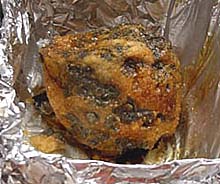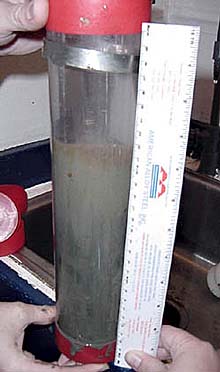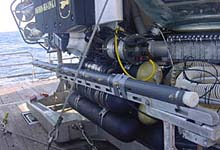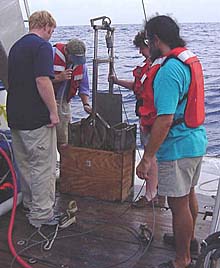
This large chunk of gas hydrate was recovered during one of our dives to a hydrate site. A thin layer of sediment and oil covers this piece of hydrate, requiring the scientist to slice it open before obtaining a “clean” hydrate-only sample. Click image for a larger view.
Leg 2 Summary: July 2-23, 2002
Heath Mills
Georgia Tech University
During this leg of the mission, microbiologists, geochemists and oceanographers came together aboard the Seward Johnson II to perform a variety of scientific experiments. The combination of sea experience and excellent weather allowed us to make successful sample collections. During our three weeks at sea, we lost only three days of dive time because of bad weather. We lost two more days due to equipment failure, but this allowed us to take a much needed break in the port city of Fourchon, LA.
Our objectives during this leg varied depending on the sample location. Dives occurred at either hydrate sites or brine pool sites. Moving back and forth between sites kept all of the researchers busy and provided some new daily challenges.

Using the Johnson Sea Link submersible, sediment cores like this one were collected from both the hydrate and brine pool sites. Click image for larger view.
The main objectives for dives on the hydrate sites included collection of gas hydrate and sediments associated with the exposed gas hydrate. We had a technical difficulty with the hydrate drill used during the previous year’s dives, forcing us to change our method for hydrate collection. To collect the volume of hydrate we needed, we used the Johnson Sea Link’s mechanical arm to grab and break off a large portion of hydrate. The hydrate was brought to the surface in a specially designed hydrate recovery chamber that kept the sample under ambient bottom temperature and pressure. This method worked extremely well; we collected enough volumes of gas hydrate for everyone to sample.
While collecting hydrate, the scientists kept a careful eye out for the elusive ice worms. We were able to capture several of these unique creatures, and by the end of the cruise, we had become fairly adept at finding and collecting them. These creatures are being examined by several of the groups on board so we can better understand their physiology.
The other main objective at the hydrate site, collecting sediment samples, was also a main objective at the brine pools. At both sites we used “Push Cores” to sample the sediment. The Push Cores, deployed using the submersible, maintains the stratification and pore water of the samples. These cores were then used for bacterial isolation, DNA and RNA extraction, fluorescent microscopy, microbial rate measurement, and stable radioisotopic analysis.

The “Brine Trapper” seen here attached to the side of the Johnson Sea Link, is a large cylinder with ten chambers cut out of the center. Each chamber can be sealed, collecting brine at different depths. Click image for a larger view.
At the brine pools, we collected different types of samples. By using a newly redesigned “Brine Trapper” we were able to collect samples from the brine pool at discreet depths. This allowed us to identify the depth of pure brine in the pool and where the brine began to mix with a large amount of very fine, black particulate matter. Although the Brine Trapper had a nasty habit of spraying the scientists with brine water while on deck, it worked very well and provided everyone with a good volume of brine sample.
Dives on either site occurred daily, twice a day. But even when the Sea Link was not in the water, we continued to sample. We frequently performed water column analyses using different equipment including a CTD (measuring the salinity, temperature and density of water at specific depths), a meter net (collecting planktonic organisms near the water surface), and a Moc-NESS (collecting planktonic organisms from different depths in the water column). We even collected bulk sediment samples between dives by using a box core.

The Box Core is a sampling device used to collect large amounts of sediment. However, unlike the push cores, these samples are not from specific locations at the sample site. Therefore, researchers use this sediment sample to provide a reference point for the data collected on-site. Click image for larger view.
Another objective of this mission incorporated both ship and submersible operations and involved mapping of the sea floor. A side scan sonar device that provided a highly detailed image of interesting bottom features was attached to the submersible during some dives. The target areas for applying the side scan sonar were identified by using a "Chirp" survey. Large tracts of the sea floor are visualized by using the acoustic reflection of the Chirp survey. Areas of interest were identified and either marked for future study or directly observed by the Sea Link. Several potential new sites were identified using this two-pronged sonar approach, sites we hope to visit on future explorations.
After several weeks at sea, the crew and scientists were ready to head back to land. We were lucky to have had such great weather and to have gathered so many samples. Many of us look forward to heading back to sea and continuing this and other lines of research.
Sign up for the Ocean Explorer E-mail Update List.























